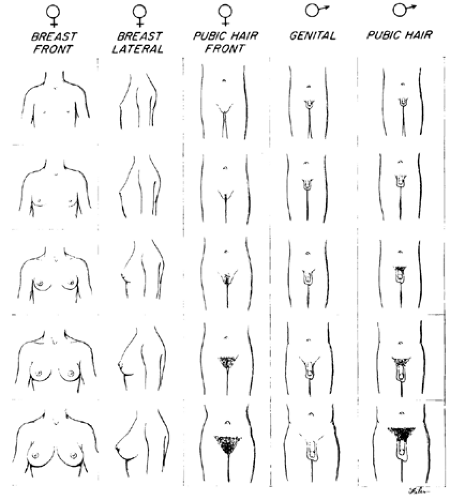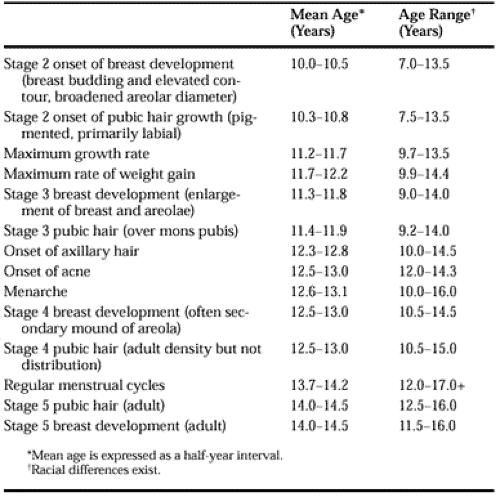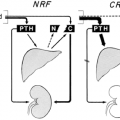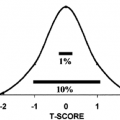FEMALE PUBERTY
Part of “CHAPTER 91 – PHYSIOLOGY OF PUBERTY“
PATTERN OF ONSET
The mean developmental pattern of female puberty is outlined in Table 91-2 and Figure 91-1A, with the mean ages and age ranges given for each event.30,31 and 32 Pubertal events have occurred progressively earlier over this century, partly paralleling the generally better socioeconomic conditions, especially nutritional
status. Racial differences exist in the onset and progression of puberty,32 although no clearly representative longitudinal or cross-sectional data exist concerning the onset and progression of puberty. The initial physical signs of puberty, both breast and pubic hair development, begin among the earliest maturers at younger ages than previously thought.32 This may occur because the ovaries are not completely quiescent during childhood and because FSH secretion is substantial during childhood, at least when compared with LH secretion. The transition from childhood to puberty appears to be subtle and gradual. Although physical changes of puberty may begin at younger ages than previously realized, significant progression may initially be slower, because the mean age and age range of menarche have not changed (see Table 91-2).
status. Racial differences exist in the onset and progression of puberty,32 although no clearly representative longitudinal or cross-sectional data exist concerning the onset and progression of puberty. The initial physical signs of puberty, both breast and pubic hair development, begin among the earliest maturers at younger ages than previously thought.32 This may occur because the ovaries are not completely quiescent during childhood and because FSH secretion is substantial during childhood, at least when compared with LH secretion. The transition from childhood to puberty appears to be subtle and gradual. Although physical changes of puberty may begin at younger ages than previously realized, significant progression may initially be slower, because the mean age and age range of menarche have not changed (see Table 91-2).
 FIGURE 91-1. Typical sequence of events at adolescence in girls (A) and boys (B) in relation to average age. The range of age at which the changes occur is also given. The numbers within the pubic hair and breast developmental sequences refer to stages of puberty (see Fig. 91-2). The age ranges differ somewhat in different population groups. (Adapted from Marshall WA, Tanner JM. Variation in pattern of pubertal changes in boys. Arch Dis Child 1970; 45:13; Clin Endocrinol Metab 1986; 15:433.) |
Pubertal development generally has been classified into five stages33 (Fig. 91-2), with stage 1 being the prepubertal state and stage 5 adulthood. Mean plasma hormone levels correlated with the five stages of development for females are listed in Table 91-3.2,20,24,34,35
 FIGURE 91-2. Five stages of puberty for females and males with two staging criteria for each sex. Stage 1 is prepuberty and stage 5 is adulthood. |
The average age for the physical onset of puberty in girls is ˜10 years, with the appearance of breast budding (thelarche). This occurs after a rise of mean circulating gonadotropin and estradiol levels and is marked by an increase of areolar diameter, a small elevation of the nipple and surrounding breast tissue, and the appearance of palpable tissue centered beneath the areolae (stage 2 of breast development). Breast budding may initially occur unilaterally; and in some instances, breast growth proceeds asymmetrically. Differences in size may persist past the pubertal years.
Stay updated, free articles. Join our Telegram channel

Full access? Get Clinical Tree








